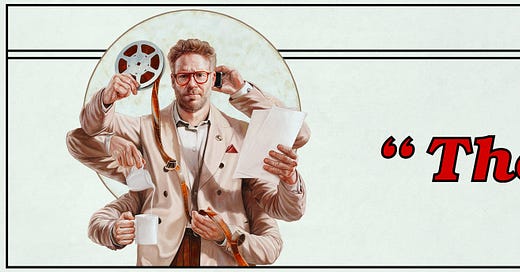I was hopeful about The Studio—and I’m happy to say it has lived up to expectations. I’ve always found Seth Rogen to be good company as an agreeable schlemiel in movies going back to The 40-Year-Old Virgin (2005) and Knocked Up (2007), when he was part of Judd Apatow’s stable. What I didn’t realize is that even then he was active behind the camera, and has been ever since. For all its wackiness, The Studio—which Rogen acts, writes, directs, and produces with a team of his own—has the assurance of someone who really knows what he’s doing in crafting an entertainment experience—and, in particular, someone who really knows movies. There are three reasons why the episodes of its debut season have been so satisfying.
The first is that the individual installments work well as stand-alone pieces. Rogen plays Matt Remick, a movie-lover who unexpectedly finds himself appointed as studio chief for the fictive (also-ran) Continental Pictures. In each segment he finds himself navigating awkward office politics, geeking out over individual productions, and allowing his eagerness to please to land him in untenable positions. All are anchored in specific plots—a distasteful order from his boss; a game of musical chairs over whose job it is to deliver unwelcome news; a lost reel in an old-school production (after an opening in which a projectionist refutes Remick’s love of celluloid with an explanation of why digital is so much better). Each gets resolved in old-school sitcom fashion, even as the world of the series ripens.
Second, The Studio is chock-full of cameos. The boss of that first episode is Bryan Cranston, playing a crass corporate type with brio, and Catherine O’Hara appears in multiple episodes as the former studio head Matt replaces. But even more fun is seeing people stars like Anthony Mackie or Charlize Theron appear as themselves. Better still are the directors—Martin Scorsese, Ron Howard, Sarah Polley—who play their parts to the hilt even as they take us behind the screen with realistic scenarios of the biz.
Finally, what’s best of all is how metatextual The Studio is. The typography of the show’s logo alludes to the 1973 Best Picture The Sting, and Remick’s character clearly aspires to be a latter-day Robert Evans, the brilliant Paramount impresario who gave us pictures like The Godfather, Chinatown, and Rosemary’s Baby in the seventies golden age of New Hollywood. (The Times recently did a piece on costuming for the show.) The joke of a Ron Howard episode is the gleeful way he plays against type as a Nice Guy. Martin Scorsese pitches one of his typically visceral but commercially problematic ideas with a script about the 1980 mass suicide at Jonestown, which Remick tries to square with an imperative to make a Kool-Aid pic along the lines of Barbie or The Lego Movie. The episode about the lost reel is executed as a Noirish detective caper, complete with dark, percussive music à la Chinatown. The series tour de force so far, though, is the second episode, “The Oner,” in which an overly enthusiastic Remick keeps on disrupting Polley’s efforts to execute a single long sunset shot along the legendary lines of Goodfellas and Boogie Nights. The joke is that the episode itself culminates in a wacky oner.
I don’t know how long The Studio will be able to sustain its manic energy and quality. But it’s already made its mark. See it on a screen near you.



